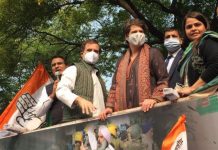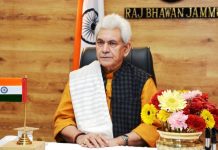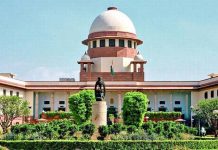With just two Lok Sabha seats, Tripura hardly matters in the parliamentary arithmetic of the country. Senio r Rashtriya Janata Dal leader and former MP Shivanand Tiwari questions the hype around the recent victory of the BJP in the North-East on this ground, saying that the results would hardly have any impact on the poll outcome of 2019. But the manner in which the outcome of the keenly-contested assembly election has been hyped points to the political significance of the victory for the BJP. The desperation shown by Prime Minister Narendra Modi and BJP President Amit Shah for winning the tiny border state too gives a glimpse of it. The duo roped in dozens of central ministers and leaders to campaign in the state and ensured that the RSS should be active in the region with all its might.
r Rashtriya Janata Dal leader and former MP Shivanand Tiwari questions the hype around the recent victory of the BJP in the North-East on this ground, saying that the results would hardly have any impact on the poll outcome of 2019. But the manner in which the outcome of the keenly-contested assembly election has been hyped points to the political significance of the victory for the BJP. The desperation shown by Prime Minister Narendra Modi and BJP President Amit Shah for winning the tiny border state too gives a glimpse of it. The duo roped in dozens of central ministers and leaders to campaign in the state and ensured that the RSS should be active in the region with all its might.
A close look at the politics of the country would only reveal that it has, by and large, become unipolar in more than one way. The consensus on economic policies among most of the mainstream political parties testifies it. There is hardly any difference among them on the policies of liberalization and globalization. The direct implication of this situation is that the corporate sector is guiding the articulation of political discourse in the country. The Left Front — CPI(M), CPI, RSP and Forward Block — is the only political block which is exception to it. It is opposed to the unipolar nature of politics and is taking clear ideological position on economic and political issues. Unlike Congress and other political parties, it opposes policies of liberalization and globalization in an unambiguous term. This is the only block which is also fiercely opposed to communal politics and hardly shows any deviation.
This is in contrast to what Congress and other parties do. They show ample political opportunism and are often soft on Hindutva or minority communalism. The recent example of Congress’ soft Hindutva could be been seen in Rahul Gandhi’s wandering in Hindu temples of Gujarat and Karnataka. This ambiguity in its policies explains why its cadres switch over to BJP so easily. It is easy for an ordinary leader of the Congress, Samajwadi Party or other mainstream political parties to switchover to the BJP. They do not feel any hesitation in speaking the language of Hindutva. Though, of late, Rahul Gandhi has started criticizing economic policies, how much change he is likely to bring in Congress’ economic policies is a matter of speculation. The thinking of Congress is still guided by persons like Manmohan Singh and P Chidambaram. They are unlikely to change their stance. What Rahul is propagating might be a liberal face of these economic policies.
Its opposition to the economic policies and its unenviable position as the champion of the cause of oppressed and marginalized sections of society — Dalits, minorities, farmers and workers — make the Left a relevant political force of the country. This is why the Left is the main enemy of the Right. So, Tripura had to be “freed” or Kerala has to be “freed” in order to demolish the ideology which talks of providing an alternative to the “Sabka Saath Sabka Vikas” model of development, which ironically has a clear bias in favour of the corporates.
How Tripura was won
The battle in Tripura was far from being fair. The media ignored all instances of violations of election-laws and bending of rules. Not a single report was published on how much money BJP spent in the polls. There were also no news on the use of religion, caste or other identities to mobilize the voters. The Supreme Court has prohibited it and the Election Commission has been reminding political parties to obey the verdict. Despite the fact that the BJP not only worked out a poll alliance based on ethnic identities but also appealed to voters to vote on the basis of it, the Election Commission or the media did not take any notice of it.
Tripura has a turbulent past. The state was witness to large scale violence in 1980s and could only recover from it in the nineties under the Left rule. Nripen Chakraborty and Manik Sarkar as chief ministers worked hard to restore the state to complete normalcy. They were able to marginalize the separatist outfits and insurgent tribal groups.
“All this has happened before in Tripura. In the mid-1980s, it was the Congress which, in a desperate bid to dislodge the Left Front in 1988 Assembly Elections, allied with the tribal group, TUJS (Tripura Upjati Samiti), a front for the violent and separatist TNV (Tripura National Volunteers). This time round, the same dangerous path has been chosen by the BJP. Bizarrely, many of the characters in this dance of death are the same. As Young men they were part of Congress or TNV/TUJS and served as their storm-troopers to spread terror in the 1980s. Now, they have joined the BJP or the IPFT (Indigenous People’s Front of Tripura) and are planning to repeat those nightmarish days,” alleges the CPI(M).
Ironically, no TV channel or newspaper highlighted the fact that militant nationalists who were effectively marginalized by the CPI(M) government have revived themselves by their alliance with the BJP. There are enough indications that IPFT will raise its demand of separate state of Tipraland and revive its secessionist demands. This may allow social tension between tribal and non-tribal populations to resurface. The state could witness clash between tribals and the Bengalis as has been the case in the past.
It is clear that the BJP has adopted the same tactics which it has adopted in Jammu and Kashmir where the party chose to join hands with the PDP which has been supporting separatists. Both in J&K and Tripura, Ram Madhav, the RSS representative in the BJP, has played an important role in formulating these alliances.
It is clear that change of guard in Tripura will affect the state in many ways. What would be its repercussion on national politics and on 2019 elections is also not difficult to assess. If the poll result has now exposed the state to accelerated tension and breakdown of hard earned social harmony, it has opened the door of realignment of political forces in the national politics.
As far as the national politics and the coming Lok Sabha polls are concerned, the BJP will certainly try to imitate its style of campaigning and other aspects of its poll strategy. Obviously, this style is in contrast to the political norms of the country.
However, Prime Minister Narendra Modi will certainly take this victory as an endorsement to his style of campaigning — high-pitched rhetoric mixed with low level attacks on opponents. His aggressive campaign is supplemented by the politically correct and manufactured social equations of his colleague Amit Shah, who uses all kinds of social cleavages to win an election.
One of the important lessons of the Tripura poll results is that the narrative of “Sabka Sath, Sabka Vikas” still attracts people. The Opposition is yet to put forth a counter narrative. Despite the fact that Tripura has done extremely well on Human Development Indices, Modi’s development narrative worked well. The state has the highest literacy in the country (96 per cent), low child mortality rate ( 20 per thousand live births), life expectancy of 71 years for men and 73 for women against the 64 and 66 in Gujarat. The state has gender ratio of 961 against 918 in Gujarat. The state has been pioneer in implementing Mahatma Gandhi National Rural Guarantee Scheme (MGNRGS) and has been able to implement all the central government schemes most effectively.
The crime rate in the state is low
Why was it that the CPI(M) could not counter the development narrative of Modi? The employment for educated youth was the only front where the state proved to be a failure. This might have given Modi an opportunity to sell his narrative of development. The CPI(M) could have easily countered the narrative by exposing the failure of the Modi government in providing growth with employment at the national level. But it failed to do so.
Decline of the Left?
The ouster of CPI(M) from the government in Tripura naturally engenders the question whether the Left is in decline. People have been asking this question ever since the Left lost its bastion in Bengal. The CPI(M) had constituted a committee with top level intellectuals on it to look into the changes in the social structure of the country after the introduction of liberal economy. The committee had given a report as well and the party had decided to implement its suggestions to mobilize the youth of the new era. However, it does not seem to have worked. The party is facing continued erosion in its base. The party also corrected its mistake of antagonizing the rural masses of West Bengal during Singur and Nandigram controversies. This also does not seem to have yielded any positive results.
The prime question before the Left is of mobilizing the new era youth that is in the grip of consumerism. However, the immediate political need demands pragmatic politics of making alliances with anti-BJP parties including Congress. Tripura polls have revealed that the Left has to position itself as an alternative to both the Congress and the BJP. It is clear that Congress’ near absence from the poll scene in Tripura helped BJP in winning it. Any strategy for the 2019 general election should keep it in mind.
The Left also needs to shun its bureaucratic style of functioning. The party seemed to have left Manik Sarkar to fight the battle on his own. His simple lifestyle and impeccable credentials as an honest chief minister were not highlighted properly. The Tripura Model of Development also did not become the poll plank, which only exposes the bureaucratic nature of functioning in the party. This is why the party mainly relied on ideological rhetoric that are best suited for academic debates. By now, Sarkar should have become a national icon for converting a troubled state into a best managed province. The CPI(M) should be made guilty of not trying to project him at national level. At times, the party should allow personalities to acquire larger than life status.
letters@tehelka.com













